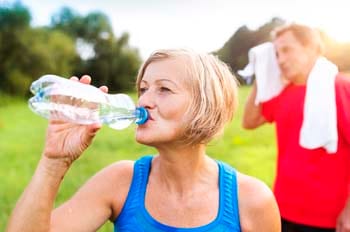An excessive heat warning was issued Wednesday morning by the National Weather Service as an area of high pressure settled over the western United States. The excessive heat warning is the highest alert issued by the NWS, and was upgraded from an excessive heat watch issued on Monday. (Whiting, 2022)
The California grid operator is asking Californians to reduce their electricity use between 4 and 9pm on Thursday through Tuesday to ease the strain on the power grid caused by high temperatures and air conditioning use — for example by setting the thermostat to 78 degrees or higher (and 85 degrees for those who are not at home). Another energy-saving request has already been issued for Thursday between 4 and 9pm, and more such requests, known as Flex Alerts, are likely during the Labor Day weekend as the worst of the heat wave hits.
Meteorologists predict all-time daily records on Saturday in Gilroy at 107, and Sunday in Livermore where it may approach or top the 113 degree set in 1950. Regionally, all areas were expected to record temperatures between 10 and 25 degrees above the daily average for Sunday and Monday.
What can you do?
- Avoid being outdoor during the late morning and afternoon
- Stay hydrated in a cool place
- Use air conditioning if available
- Use shade, sunblock, and misters
Take measures to stay cool, stay hydrated, and stay informed. Getting too hot can make you sick. You can become ill from the heat if your body can’t compensate for it and properly cool you off. The main things affecting your body’s ability to cool itself during extremely hot weather are:
- High humidity. When the humidity is high, sweat won’t evaporate as quickly. This keeps your body from releasing heat as fast as it may need to.
- Personal factors. Age, obesity, fever, dehydration, heart disease, mental illness, poor circulation, sunburn, and prescription drug and alcohol use all can play a role in whether a person can cool off enough in very hot weather.

People aged 65 and older are at high risk for heat-related illnesses.
Those who are at highest risk include people 65 and older, children younger than two, and people with chronic diseases or mental illness.
Closely monitor people who depend on you for their care and ask these questions:
- Are they drinking enough water?
- Do they have access to air conditioning?
- Do they need help keeping cool?
People at greatest risk for heat-related illness can take the following protective actions to prevent illness or death:
- Stay in air-conditioned buildings as much as you can. Air-conditioning is the number one way to protect yourself against heat-related illness and death. If your home is not air-conditioned, reduce your risk for heat-related illness by spending time in public facilities that are air-conditioned and using air conditioning in vehicles. Contact your local health department or locate an air-conditioned shelter in your area.
- Do not rely on a fan as your main cooling device during an extreme heat event.
- Drink more water than usual and don’t wait until you’re thirsty to drink.
- Check on a friend or neighbor and have someone do the same for you.
- Limit use of the stove and oven—it will make you and your house hotter.
Even young and healthy people can get sick from the heat if they participate in strenuous physical activities during hot weather:
- Limit your outdoor activity, especially midday when the sun is hottest.
- Pace your activity. Start activities slowly and pick up the pace gradually.
- Drink more water than usual and don’t wait until you’re thirsty to drink more. Muscle cramping may be an early sign of heat-related illness.
- Wear loose, lightweight, light-colored clothing.
If you play a sport that practices during hot weather, protect yourself and look out for your teammates:
- Schedule workouts and practices earlier or later in the day when the temperature is cooler.
- Monitor a teammate’s condition and have someone do the same for you.
- Seek medical care right away if you or a teammate has symptoms of heat-related illness.
- Learn more about how to protect young athletes from heat-related illness by taking this CDC course.
Everyone should take these steps to prevent heat-related illnesses, injuries, and death during hot weather:
- Stay in an air-conditioned indoor location as much as you can.
- Drink plenty of fluids even if you don’t feel thirsty.
- Schedule outdoor activities carefully.
- Wear loose, lightweight, light-colored clothing and sunscreen.
- Pace yourself.
- Take cool showers or baths to cool down.
- Check on a friend or neighbor and have someone do the same for you.
- Never leave children or pets in cars.
- Check the local news for health and safety updates.
***For more information: visit the CDC at https://www.cdc.gov/nceh/features/extremeheat/index.html
